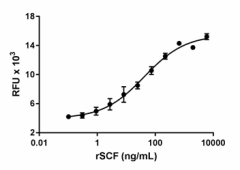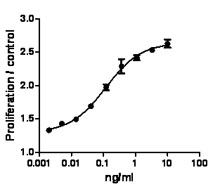- Regulatory Status
- RUO
- Other Names
- KIT-ligand, Kitl, KL-1, mast cell grow factor (MGF), steel factor (SF), FPH2, SHEP7
- Ave. Rating
- Submit a Review
- Product Citations
- publications

-

Recombinant rat SCF induces the proliferation of human TF-1 cells. The ED50 for this effect is 20 – 60 ng/mL.
| Cat # | Size | Price | Quantity Check Availability | Save | ||
|---|---|---|---|---|---|---|
| 782301 | 2 µg | 72€ | ||||
| 782302 | 10 µg | 179€ | ||||
This product is not available for shipping outside of the United States.
Rat SCF was identified and purified from buffalo rat liver-conditioned medium. It is synthesized as a membrane-bound form of 273 amino acids. The protein contains a proteolytic cleavage site that is cleaved from the cell to release an active soluble protein. The soluble SCF is glycosylated at both N-linked and O-linked sites. MMP-9 plays a physiological role in SCF release from the membrane, and this action has a significant part in differentiating and mobilizing stem and progenitors cells from the bone marrow. SCF increases the proliferation of myeloid and lymphoid hematopoietic progenitors in bone marrow cultures. SCF/c-kit interaction in mast cells results in mast cell degranulation and liberation of mediators, such as histamine, inflammatory cytokines, and chemokines. Also, activation of c-kit in dendritic cells regulates T helper cell differentiation and allergic asthma. In addition, SCF plays an important role in revascularization of ischemic limbs. Ischemia induces plasma elevation of SCF and thrombopoietin (TPO) and lower levels of GM-CSF and erythropoietin (EPO). SCF and TPO induce the release of CXCL12 from platelets thereby increasing CXCL12 levels in plasma. This results in an extensive mobilization of CXCR4+VEGFR1+ cells (hemangiocytes) accelerating revascularization of the ischemic limbs. SCF and its receptor (c-kit) drive the recruitment and expansion of different stem cell types, including hematopoietic, neuronal, germ, and cardiac. SCF gene transfer promotes cardiac repair after myocardial infarction via in situ recruitment and expansion of c-kit+ cells. Also, c-kit signaling plays a key role in the pancreas, including islet morphogenesis, islet vascularization, and beta cell survival and function.
Product DetailsProduct Details
- Source
- Rat SCF, amino acid Met - (Gln26– Ala189) (Accession # NP_068615.1) was expressed in E.coli.
- Molecular Mass
- The 165 amino acid recombinant protein has a predicted molecular mass of approximately 18.4 kD. The predicted N-terminal amino acid is Met.
- Purity
- ≥ 98% by SDS-PAGE gel and HPLC analyses.
- Formulation
- Lyophilize from sterile 0.22 μm filtered protein solution is in PBS pH7.2.
- Endotoxin Level
- Less than 0.1 EU per µg protein as determined by the LAL method.
- Concentration
- Lyophilized recombinant protein is at 2 and 10 μg total protein
- Storage & Handling
- Unopened vial can be stored between 2°C and 8°C for one month, at -20°C for six months, or at -70°C for one year. For maximum results, quick spin vial prior to opening. Reconstitute the protein in sterile water at 0.1 mg/ml. The protein can be aliquoted and stored at -20°C to -70°C. Stock solutions can also be prepared at 50 - 100 µg/mL in sterile buffer (PBS, HPBS, DPBS, or EBSS) containing carrier protein such as 0.2 - 1% BSA or HSA and stored in working aliquots at -20°C to -70°C. Avoid repeated freeze/thaw cycles.
- Activity
- Recombinant rat SCF induces the proliferation of human TF-1 cells in a dose-dependent manner. The proliferation was measured using the Deep Blue Cell Viability™ Kit (Cat. No. 424701). The ED50 for this effect is 20 – 60 ng/mL.
- Application
-
Bioassay
- Application Notes
-
BioLegend carrier-free recombinant proteins provided in lliophylized format are shipped on blue ice.
Antigen Details
- Structure
- Homodimer
- Distribution
-
Fibroblast, keratinocytes, endothelial cells, and smooth muscle cells.
- Function
- SCF promotes growth, differentiation, and activation of mast cells, takes part in early stages of hematopoiesis, erythropoiesis, development of melanocytes, gametogenesis, and the survival of Cajal cells from the intestine.
- Interaction
- Mast cells, natural killer cells, dendritic cells, eosinophils, epithelial, endothelial, melanocytes, germen cells, cholangiocytes, platelets, myeloid leukaemia cells, and intestinal cells of Cajal.
- Ligand/Receptor
- c-kit (CD117)
- Bioactivity
- Rat SCF induces the proliferation of human TF-1 cells.
- Cell Type
- Hematopoietic stem and progenitors, Embryonic Stem Cells
- Biology Area
- Angiogenesis, Cell Biology, Immunology, Signal Transduction, Stem Cells
- Molecular Family
- Cytokines/Chemokines, Growth Factors
- Antigen References
-
- Zsebo KM, et al. 1990. Cell. 63(1):195-201
- Lu HS, et al. 1996. J Biol Chem. 271:11309.
- Heissig B, et al. 2002. Cell. 109:625.
- Jin DK, et al. 2006. Nat Med. 12:557.
- Krishnamoorthy N, et al. 2008. Nat Med. 14:565.
- Ray P, et al. 2010. Ann N Y Acad Sci. 1183:104.
- Yaniz-Galende E, et al. 2012. Circ Res. 111:1434.
- Feng ZC, et al. 2015. Diabetologia. 58:654.
- Gene ID
- 60427 View all products for this Gene ID
- UniProt
- View information about SCF on UniProt.org
Related FAQs
- Why choose BioLegend recombinant proteins?
-
• Each lot of product is quality-tested for bioactivity as indicated on the data sheet.
• Greater than 95% Purity or higher, tested on every lot of product.
• 100% Satisfaction Guarantee for quality performance, stability, and consistency.
• Ready-to-use liquid format saves time and reduces challenges associated with reconstitution.
• Bulk and customization available. Contact us.
• Learn more about our Recombinant Proteins. - How does the activity of your recombinant proteins compare to competitors?
-
We quality control each and every lot of recombinant protein. Not only do we check its bioactivity, but we also compare it against other commercially available recombinant proteins. We make sure each recombinant protein’s activity is at least as good as or better than the competition’s. In order to provide you with the best possible product, we ensure that our testing process is rigorous and thorough. If you’re curious and eager to make the switch to BioLegend recombinants, contact your sales representative today!
- What is the specific activity or ED50 of my recombinant protein?
-
The specific activity range of the protein is indicated on the product datasheets. Because the exact activity values on a per unit basis can largely fluctuate depending on a number of factors, including the nature of the assay, cell density, age of cells/passage number, culture media used, and end user technique, the specific activity is best defined as a range and we guarantee the specific activity of all our lots will be within the range indicated on the datasheet. Please note this only applies to recombinants labeled for use in bioassays. ELISA standard recombinant proteins are not recommended for bioassay usage as they are not tested for these applications.
- Have your recombinants been tested for stability?
-
Our testing shows that the recombinant proteins are able to withstand room temperature for a week without losing activity. In addition the recombinant proteins were also found to withstand four cycles of freeze and thaw without losing activity.
- Does specific activity of a recombinant protein vary between lots?
-
Specific activity will vary for each lot and for the type of experiment that is done to validate it, but all passed lots will have activity within the established ED50 range for the product and we guarantee that our products will have lot-to-lot consistency. Please conduct an experiment-specific validation to find the optimal ED50 for your system.
- How do you convert activity as an ED50 in ng/ml to a specific activity in Units/mg?
-
Use formula Specific activity (Units/mg) = 10^6/ ED50 (ng/mL)
 Login / Register
Login / Register 












Follow Us